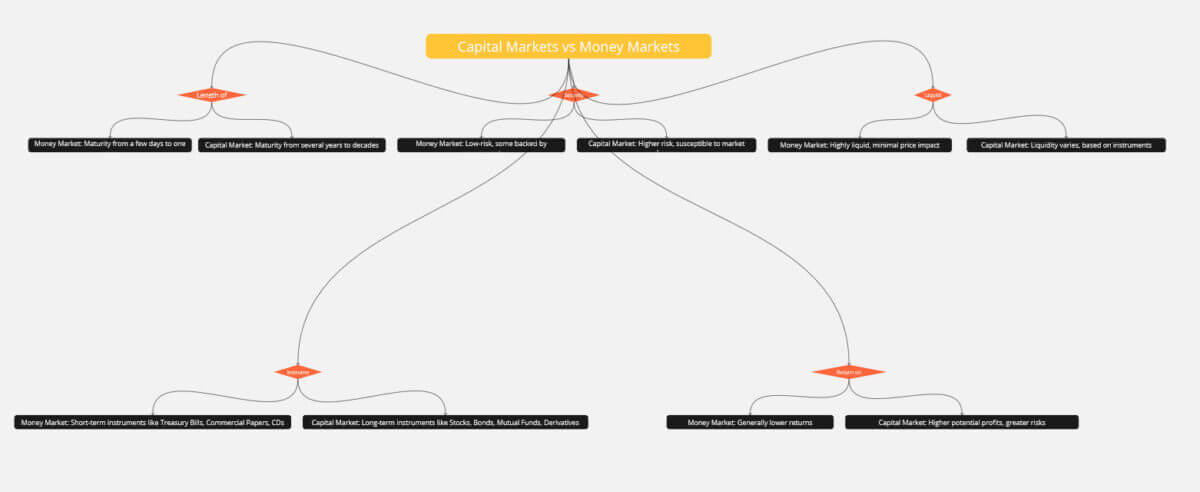
Capital market and money market – side by side comparison
The Capital Market and the Money Market play pivotal roles in the global economy. They serve as the backbone of the funds in the economy. They facilitate the flow of funds, support government financing, and provide investment opportunities for individuals and institutions. In this comparison, we will dissect the Capital Market and Money Market based on various criteria.
Money market vs capital market explained
The money market and the capital market represent the two different types of financial markets.
Money Market
The money market is suitable for short term debt.
Money markets include the following:
- bank accounts
- Bills of exchange,
- collateral loans
- interbank loans (loans between banks)
- money market mutual funds; commercial paper
- treasury bills
- and securities lending and repurchase agreements (repos).
On the money market, the returns can be modest but the risks are low. Institutions operating in the money markets include the Federal Reserve, commercial banks, and acceptance houses.
Typically, when a corporation or administration offers temporary loans, it primarily funds everyday operational costs or provides working capital, rather than for enhancing infrastructure or undertaking major initiatives.
The central bank has the option to offload some of its tradable assets in the money market or in markets closely linked to the money market. The central bank will facilitate the payment for these assets by reducing the reserve balances of commercial banks in its records.
Capital Market
In contrast, the capital market is suitable for long-term assets and long term investment with a maturity of more than one year ( long term securities).
Types of capital markets:
- Stock markets, stock exchange,
- debt market,
- Forex market,
- derivatives and commodities market,
- mortgage market.
The capital market can be primary and secondary. The supply and demand for capital meet on the primary. The securities trade takes place on the secondary.
Capital market and money market – side by side comparison
Instruments
Money market instruments are predominantly short-term financial instruments designed to meet the liquidity needs of borrowers and investors. Key money market instruments include Treasury Bills, Commercial Papers, and Certificates of Deposit (CDs).
Capital market instruments, on the other hand, gear towards long-term financing and investment. They encompass various financial instruments such as stocks, bonds, mutual funds, and derivatives.
Length of Securities
Money market securities have relatively short periods to maturity, typically ranging from a few days to one year. Longer maturities characterize capital market securities. Stocks and bonds, which are prevalent in the capital market, can have maturities extending from several years to several decades.
Security Risks
People generally consider money market instruments as low-risk investments. For example, the government’s creditworthiness backs Treasury Bills, making them almost risk-free. Commercial Papers and Certificates of Deposit carry slightly more risk but remain relatively safe.
Investing in the capital market involves a greater level of risk than money market instruments. Shares are susceptible to market instability and can undergo substantial price changes.
Liquidity
Liquidity is a hallmark of the money market. Money market instruments are highly liquid, meaning you can buy or sell them easily with minimal price impact.
The level of liquidity in the capital market differs based on the specific financial instruments involved.
Return on Investment
Returns on money market investments are generally lower compared to the capital market..
Investing in the capital market can potentially yield greater profits, but it also entails greater risks.
For instance, stocks have the potential for significant capital gains and regular dividend payments. Conversely, bonds earn income through interest based on the issuer’s creditworthiness and current interest rates.
Deciding Which Market to Invest In
If you are hesitating between these two markets for your investments here is the thing. Your investment depends on your goals, risk tolerance and investment style.
Highly liquid investment at modest rates and minimal risk money market is a good option. If you want to have a bigger risk appetite to earn higher returns you might lean toward the capital market instead. The best is to diversify your investments.
Diversification allows for balanced risk investment and creation of a portfolio that will bring the kind of returns you want.
The alternatives to the money market and the capital market?
In addition to the financial markets, there are alternative options to store money that you don’t intend to use immediately.
- Certificate of deposit
- High yield checking account
- Traditional saving account
Traditional Savings Accounts
A savings account offers a safe haven for your funds while allowing you to accrue interest. Various types of savings accounts include:
- Regular savings accounts offered at banks.
- Credit union savings accounts.
- High-yield savings accounts from online banks.
Among the choices available, an online savings account usually offers the most attractive interest rates with minimal fees. However, the downside is the lack of access to physical branch banking, which could be a concern depending on your preferences.
Certificate of Deposits
A Certificate of Deposit (CD) is a financial instrument offered by banks and credit unions that allows individuals to deposit a sum of money for a fixed period at a specified interest rate.
People recognize CDs for their safety, and they typically offer higher interest rates than regular savings accounts . Actually, they require depositors to leave the funds untouched for a specific duration, called the maturity period.
High-Yield Checking Accounts
A high-yield checking account is a type of bank account that offers a significantly higher interest rate than traditional checking accounts.
These accounts typically provide a competitive yield on deposited funds, allowing account holders to earn more on their balances while retaining the convenience of a checking account for everyday financial transactions.
High-yield checking accounts often have certain requirements, such as minimum balance thresholds or a specified number of monthly debit card transactions, to qualify for the higher interest rate.





